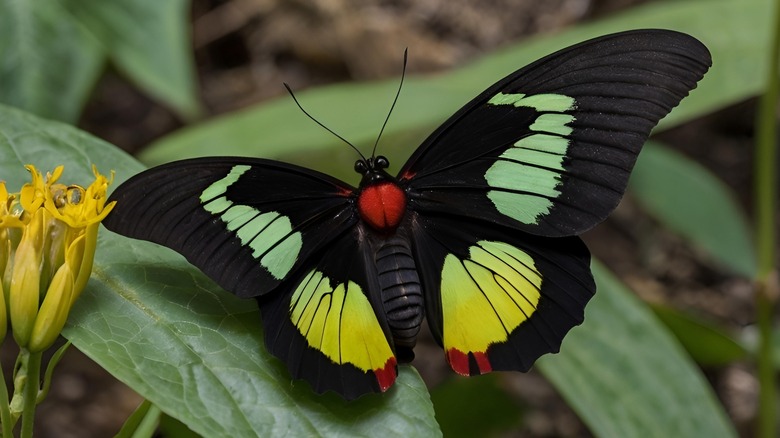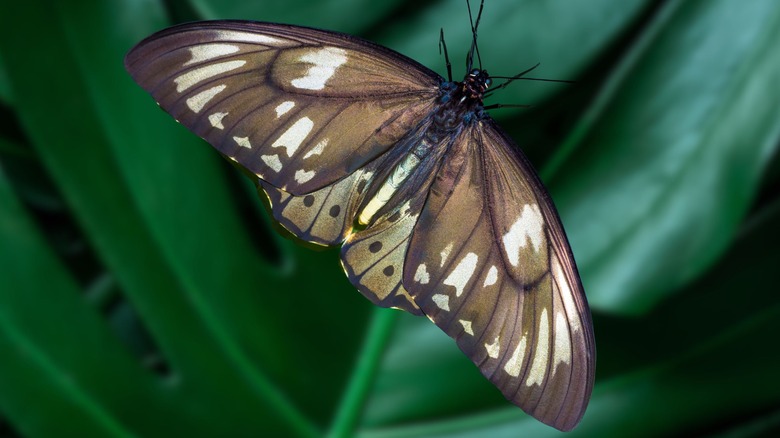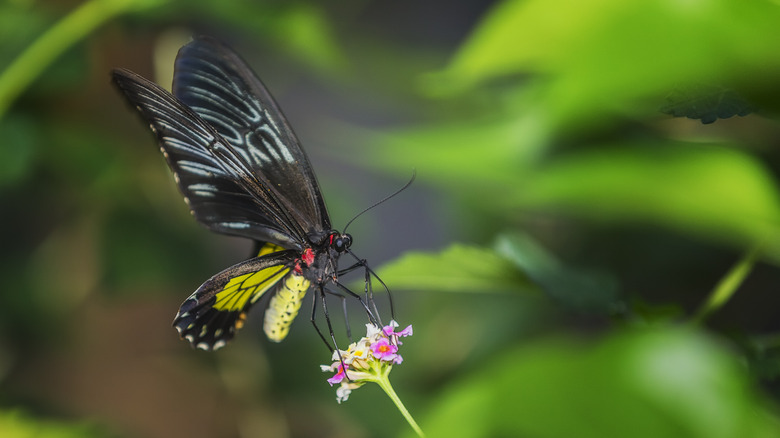The World's Largest Butterfly Is Facing Two Human Threats
We may receive a commission on purchases made from links.
If you hadn't heard, experts believe we're experiencing an insect apocalypse – one which has already seen a dramatic decrease in insect numbers worldwide — and butterflies are no exception. A startling number of the winged insects have disappeared in recent times, which is actually why you're not seeing as many butterflies as you did when you were a kid. The world's largest butterfly, the Queen Alexandra's birdwing (Ornithoptera alexandrae), in particular is facing two major threats from humans: habitat loss and the black market trade.
To be clear, it's the female Queen Alexandra's birdwing that represents the largest butterfly in the world, with a wingspan of around 10.6 inches. Discovered in 1906 by British explorer Albert Stewart Meek, the Queen Alexandra's birdwing was named in honor of England's then monarch Edward VII's wife and is only found in Papua New Guinea. The striking iridescent blue, green, and yellow markings of the male, and the brown and white-yellow markings of the female make the species easily one of the most beautiful in the world. But it's also one of the rarest, existing only in two regions. One is the Popondetta Plain — a flat coastal area in Oro Province, Papua New Guinea — and the other is within the rainforest of the Managalas Plateau.
Sadly, this rare butterfly, which has inspired fascination since its discovery more than a century ago, is now imperiled due to habitat loss and a highly lucrative black market that thrives on the Queen Alexandra's birdwing being so sought after.
Habitat loss has gravely threatened the Queen Alexandra's birdwing
Butterflies belong to the order Lepidoptera, which includes 160,000 species of butterflies and moths. Sadly, that number looks set to decline very quickly, with five butterfly species having gone extinct since 1950, and according to recent studies, more are set to go the same way. Rare species, such as the Sacramento Mountains checkerspot butterfly — one of several endangered New Mexico species — face a particularly uncertain future.
The Queen Alexandra's birdwing is no different, and it may even be one of the most threatened butterfly species in the world. When Albert Meek discovered the butterfly, he took down his first specimen with a shotgun blast — a disturbing but apt action that turned out to be a grim portent of things to come, given the butterfly is now listed as endangered by the U.S. Fish and Wildlife service. In 1996, it was added to the International Union for Conservation of Nature (IUCN) Red List, where it's been categorized as endangered since 2018.
Once widespread in Oro province's rainforests, the butterfly has been forced into a comparatively tiny region due to habitat loss resulting from oil palm plantation, coffee and cocoa growth, and logging. It didn't help that in 1951, a volcano on Mount Lamington erupted, destroying significant areas of the Queen Alexandra butterfly's habitat. But the expansion of the aforementioned industries has severely reduced that habitat even further in the decades since, destroying the food plant vines that the butterfly relies on to reproduce.
It's not known exactly how many Queen Alexandra's birdwings exist today. The 2018 IUCN assessment did, however, identify the species as "very rare" and noted that it had a "very restricted" habitat at the time, occurring within just 8,710 square kilometers (3,363 square miles) and occupying between 128 and 140 square kilometers (50 and 54 square miles).
Queen Alexandra's birdwings are highly desirable black market items
It's not just habitat loss that's causing the Queen Alexandra's birdwing numbers to dwindle, though. The species is also highly sought after by collectors and has been added to the Convention on International Trade in Endangered Species (CITES) — a treaty designed to prevent illegal trade of endangered plants and animals. Collecting the butterfly has been illegal since 1968, but that hasn't stopped a black market from thriving.
In 2001, there was the arrest of Canadian Gilles Deslisle, who was fined $50,000 (CAD) for illegally importing six Queen Alexandra's birdwings concealed in a hollowed-out hardback book. It only made matters worse that Deslisle was a well-known entomologist.
Then, in 2007, U.S. authorities captured Hisayoshi Kojima, the world's biggest butterfly smuggler who had made hundreds of thousands of dollars via his illicit trade. He was charging between $8,500 and $10,000 for a Queen Alexandra — one of the most desirable and rare butterfly specimens in the world. At the time Kojima was caught, the illegal trade of endangered species was estimated to be worth between $10 billion and $15 billion annually, and in her 2011 book "Winged Obsession: Chasing the Illegal Trade," author Jessica Speart estimated the global illegal butterfly trade to be worth $200 million a year. With the Queen Alexandra being so prized, this hugely profitable illegal industry is another major threat to a species that is already highly imperiled.


